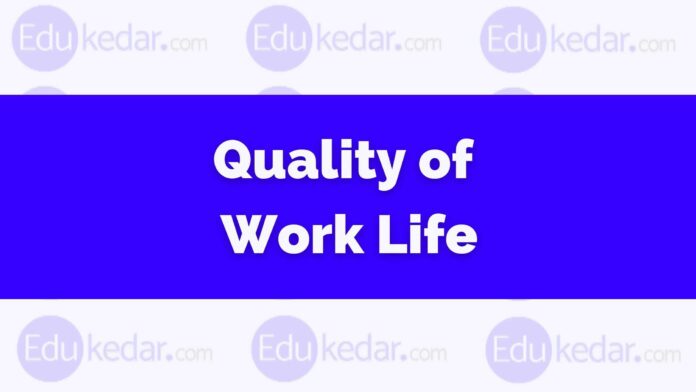Work-life balance describes the when, where and how individuals work, leading them to be able to enjoy an optimal quality of life. Here we have discussed what is Quality of Work Life in HRM, Its meaning and various definitions given by different experts, Its factors, Its impact, and different ways to increase the work-life balance.
Work is considered an integral part of our everyday life. We spend around half of our day daily in the workplace, it does influence the overall quality of our life.
If an employee is happy with work-life it yields job satisfaction, gives peace of mind, and fulfillment of having done a task, as it is expected, without any flaw, and having spent the time fruitfully, constructively, and purposefully.
Even if it is a small step towards our lifetime goal, at the end of the day it gives satisfaction and eagerness to look forward to the next day.
Work-life balance is achieved when an individual’s right to a fulfilled life inside and outside paid work is accepted and respected as the norm, for the mutual benefit of the individual, business, and society.
► What is the Quality of Work Life in HRM?
The term Quality of Work Life in HRM means an attempt to change the entire organizational climate so that employees get a better opportunity to grow and develop which can benefit the company in terms of productivity, employee loyalty, and company reputation.
QWL is very beneficial to provide a more humanized and employee-centric work environment and also considers the socio-psychological needs of the employees.
It endeavors to serve different types of employee needs that help them to enhance work-life quality.
It seeks to outline many things like improving and imparting new skills to employees, should not put employees under undue stress, should not damage or degrading employee freedom and dignity in the workplace.
◉ Quality of Work-Life Meaning
Quality of work life is described as a concept that decides the favorableness or unfavorableness of the job environment of an organization for its employees.
In simple words, this term covers an employer’s feelings through various dimensions of his work e.g. economic incentives and rewards, job security, organization structure, working conditions, organizational and interpersonal relationships, etc.
Quality of Work Life is considered as a degree to which employees of an organization are able to satisfy their personal needs through experience in the organization. It main aim is to create a work environment where employees work in cooperation with each other and contribute to organizational objectives
◉ Definition of Work-Life Balance
“Quality of Work Life is the degree to which work in an organization contributes to the material and psychological well-being of its members.” – Harrison
“Quality of Work Life is a process of joint decision making, collaborations and building mutual respect between management and employees.” – D.S.Cohan
“Quality of Work Life is a process of work organization which enables its members at all levels to participate actively and effectively in shaping the organizations’ environment, methods, and outcomes. It is a value-based process which is aimed towards meeting the twin goals of enhanced effectiveness of the organization and improved quality of life at work for the employees”. – American Society of Training and Development
► Importance of Quality of Work Life
- Decrease absenteeism and employee turnover in an organization
- Ensure less number of accidents or employee injury
- Improved management and employee relationship
- Enhance the company’s corporate image and reputation
- Positive employee attitudes toward their work and the company
- Increased productivity and motivation of employee
- Enhanced organizational effectiveness and provide a competitive advantage to the organization
- Promote a sense of belongingness among employees toward the organization.
► Factors Affecting the Quality of Work Life
The factors that influence and decide the Quality of work life are:
- Individual Attitude
- Work Culture and Working Environment
- Opportunities
- Nature of Job
- People
- Reward and Recognition
- Career Prospects
◉ Individual Attitude – It includes a commitment to work, enthusiasm, eagerness to learn, innovation, competitiveness, team spirit, interpersonal skills, leadership quality, etc.
◉ Work culture and working environment – It include organization structure, working style, organization policies, leadership style, employee behavior, workplace amenities, employee interpersonal behavior, communication style, etc.
◉ Opportunities – These include opportunities for promotion, participation in decision making
◉ Nature of Job – It includes complexity of task, basic or routine task, role, and responsibility, job title, designation, deadline, work pressure, stress, etc.
◉ People – It includes colleagues, bosses, superiors, juniors, team members, etc.
◉ Reward and Recognition – It includes incentives, fringe benefits, perks and remuneration, profit-sharing programs, remuneration, new job title, formal and informal acknowledgment of employees, etc.
◉ Career Prospects – It includes employee career planning and development, and opportunities to increase career.
► Positive Impact of Good quality Work Life
Positive Impact and Advantages of Good quality Work Life on employees.
- Enhance job satisfaction
- Positive attitude and optimistic
- Increase motivation level
- Ensure peace and tranquility
- Promote happy personal and work-life balance
- High employee loyalty
- No stress
- High creativity and innovation
- Good physical and mental health
► Negative Impact of Poor Quality Work Life
Negative Impact and disadvantages of QWL on employees.
- Develop negative attitude
- Feel demotivated and have a low commitment to the job
- Negative attitude and pessimistic
- Low job satisfaction
- High employee turnover
- Low work productivity
- High level of stress and anxiety
- Poor physical and mental health
- Addicted to drugs
► Ways to increase the Quality of Work Life
Ensuring a positive and high quality of work life is the priority of both organizations and individuals. There are some widely accepted and renowned techniques used to improve the QWL as given below:
- Flexible Work Schedules
- Job Redesign
- Compensation, Recognization, and Reward
- Opportunity for Development
- Autonomous Work Groups
- Employee Participation in management
- Job and Social Security
- Equitable and Fast Delivery of Justice
- Recognition of Work-life Issues
- Provide Training as per Requirement
✔ Flexible Work Schedules
Today’s workforce does not want to work for fixed hours or days. Employees demand alternative work schedules flexi-time, staggered hours, compressed work weeks, work from home, etc. The flexibility in their work schedule so that professional and personal life can be managed together.
✔ Job Redesign
One of the best ways to ensure good quality of work life is job redesigning or job enrichment or job enlargement.
All these techniques will end boredom and monotony in the work routine and provide exciting, interesting, stimulating, and challenging work. It helps to satisfy the higher-level needs of the employees.
✔ Compensation, Recognization, and Reward
For providing good quality of work life it is the duty of the organization to reward the employees for their exceptional efforts. There should be just an equitable balance between the effort and the reward.
If an organization reward or recognize an employee for work it should not only motivate that employee but also motivate other employees to push harder themselves if they want to reward and recognization.
✔ Opportunity for Development
Career development and growth is very important for ambitious and achievement-oriented employees. If an organization provide ample opportunities to employees for their advancement and growth, that makes employee highly motivated and their commitment toward task and the organization will increase sharply.
✔ Autonomous Work Groups
Autonomous work groups are self-managed work teams that not only have freedom of decision-making but are also responsible for their success or failures.
Currently, organizations adopt delegation as an essential constituent of organization structure which promotes freedom ensuring, open communication, respect and recognition, trust, etc.
✔ Employee’s Participation in management
Participation of employees in decision-making helps employees improve the Quality of Work Life. Organizations should adopt methods like Quality circles, Management by objectives, and suggestion system to ensure the participation of employees in management and also promote and maintain a work environment that results in excellence in results.
✔ Job and Social Security
Every employee wants stability of employment. If organizations provide job security and all social security measures that will definitely improve the Quality of Work Life to a large extent because now employees have a sense of relief that employee
✔ Equitable and Fast Delivery of Justice
One of the key and deciding approaches to ensure good work-life quality is equitable and timely delivery of justice.
Organization management ensures the implementation of equitable administrative justice in all disciplinary actions, grievance redressal procedures, performance appraisal, transfers, work assignments, etc.
✔ Recognition of Work-Life issues
Organizations should address employees’ issues related to work-life by framing their employees-centric policies and procedure.
The higher management of organizations like the Board of members and board of directors should take Suo moto cognizance of employees regarding why employees are not happy, do they need training, why employee morale is poor, and numerous other issues.
✔ Provide Training as per Requirement
One of the ways to enhance work-life quality and minimize job dissatisfaction is to provide regular training to the employee so that they feel more engaged toward work and minimize the incidence of error and accident which enhance employee confidence.
Related HR Topics
- What is Quality Circle?
- History of Quality Control (QC Techniques)
- Planning in Management
- Organizing in Management
- Staffing in Management
- Directing in Management
- Controlling in Management
- Steps in Planning Process
- Human Resource Planning
- Types of Plans
- Succession Planning
- Human Resource Development





